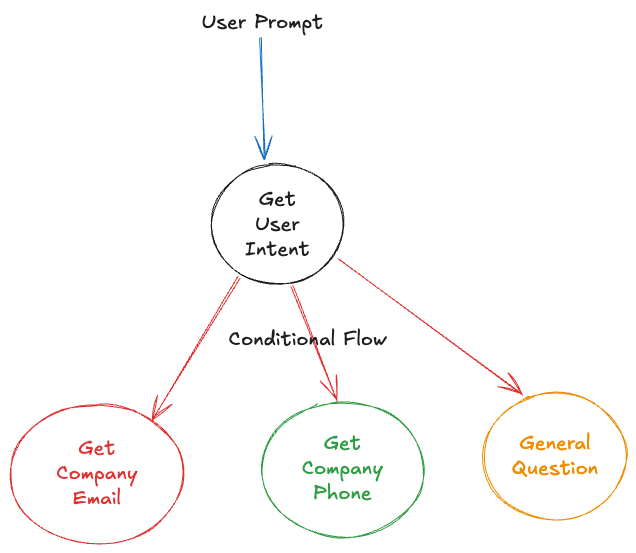20 March 2025
Intention-based routing in langgraph involves using conditional logic to direct the flow within the graph based on user intention. We can use the LLM to capture the user intent and use langgraph routing features to send the request to the appropriate node or subgraph.
As usual, here is a graph of what we are going to build. It is super simple but it shows the routing capabilities in langgraph

I am going to use the following packages.
langchain==0.3.21
langchain-openai==0.3.9
langgraph==0.3.18
openai==1.67.0
Lets create the utils function to use in our graph.
# api.py
import langchain
from langchain_openai import ChatOpenAI
from langchain_core.prompts import ChatPromptTemplate
from langchain_core.output_parsers import StrOutputParser
langchain.verbose = False
langchain.debug = False
langchain.llm_cache = False
class Langchain:
"""Langchain Class"""
@staticmethod
def create_chat_chain(
openai_api_key: str,
model_name="gpt-4o-mini",
temperature=0,
prompt_template=None,
callbacks=[],
):
prompt = ChatPromptTemplate.from_messages(prompt_template)
llm = ChatOpenAI(
openai_api_key=openai_api_key,
model_name=model_name,
temperature=temperature,
callbacks=callbacks,
)
chain = prompt | llm | StrOutputParser()
return chain
def get_user_intent(
openai_api_key: str,
prompt: str,
intents: list[str],
model_name="gpt-4o-mini",
temperature=0,
) -> str:
chain = Langchain.create_chat_chain(
openai_api_key,
model_name,
temperature,
[
(
"system",
"You are a helpful assistant that provides the user intent from a list of intents.",
),
(
"user",
f"Provide the intent value ONLY of user prompt {prompt} from these intent list {intents}",
),
],
[],
)
return chain.invoke({})
def answer_general_user_question(
openai_api_key: str,
prompt: str,
model_name="gpt-4o-mini",
temperature=0,
) -> str:
chain = Langchain.create_chat_chain(
openai_api_key,
model_name,
temperature,
[
(
"system",
"You are a helpful assistant that answers general user questions.",
),
(
"user",
f"Provide an answer to this prompt and make it less formal {prompt}",
),
],
[],
)
return chain.invoke({})
and then, lets build the graph itself.
# graph.py
import os
from typing import TypedDict, Dict
from langgraph.graph import StateGraph, START, END
from api import answer_general_user_question
from api import get_user_intent
class MainState(TypedDict):
messages: list[Dict[str, str]]
def ask(state: MainState) -> MainState:
msg = "Hi there, How can i help you?"
prompt = input(f"{msg}\n")
state["messages"].append({"role": "assistant", "content": msg})
state["messages"].append({"role": "user", "content": prompt})
return state
def get_intent(state: MainState) -> MainState:
intent = get_user_intent(
os.environ.get("OPENAI_API_KEY"),
state.get("messages")[-1].get("content"),
["get_company_phone", "get_company_email"]
)
state["messages"].append({"role": "system", "content": intent})
return state
def decide(state: MainState) -> MainState:
if state.get("messages")[-1].get("content") not in ["get_company_email", "get_company_phone"]:
return "unknown"
return state.get("messages")[-1].get("content")
def get_company_phone(state: MainState) -> MainState:
state["messages"].append({"role": "assistant", "content": "The company phone is +2352553423"})
return state
def get_company_email(state: MainState) -> MainState:
state["messages"].append({"role": "assistant", "content": "The company email is [email protected]"})
return state
def unknown(state: MainState) -> MainState:
answer = answer_general_user_question(
os.environ.get("OPENAI_API_KEY"),
state.get("messages")[-1].get("content")
)
state["messages"].append({"role": "assistant", "content": answer})
return state
main_graph = StateGraph(MainState)
main_graph.add_node("ask", ask)
main_graph.add_node("get_intent", get_intent)
main_graph.add_node("decide", decide)
main_graph.add_node("get_company_email", get_company_email)
main_graph.add_node("get_company_phone", get_company_phone)
main_graph.add_node("unknown", unknown)
main_graph.add_edge(START, "ask")
main_graph.add_edge("ask", "get_intent")
main_graph.add_conditional_edges("get_intent", decide)
main_graph.add_edge("get_company_email", END)
main_graph.add_edge("get_company_phone", END)
main_graph.add_edge("unknown", END)
main_graph.set_entry_point("ask")
app = main_graph.compile()
while True:
for event in app.stream(
{
"messages": [],
}
):
for value in event.values():
if (
value
and len(value["messages"]) > 0
and value.get("messages")[-1].get("role") == "assistant"
):
print(value.get("messages")[-1].get("content"), "\n")
break
and to run the graph
$ export OPENAI_API_KEY=XXXXXXX
$ python main.py
Hi there, How can i help you?
What is langgraph company phone number?
The company phone is +2352553423
$ export OPENAI_API_KEY=XXXXXXX
$ python main.py
Hi there, How can i help you?
What is the email address?
The company email is [email protected]
You can see the full source code here on github